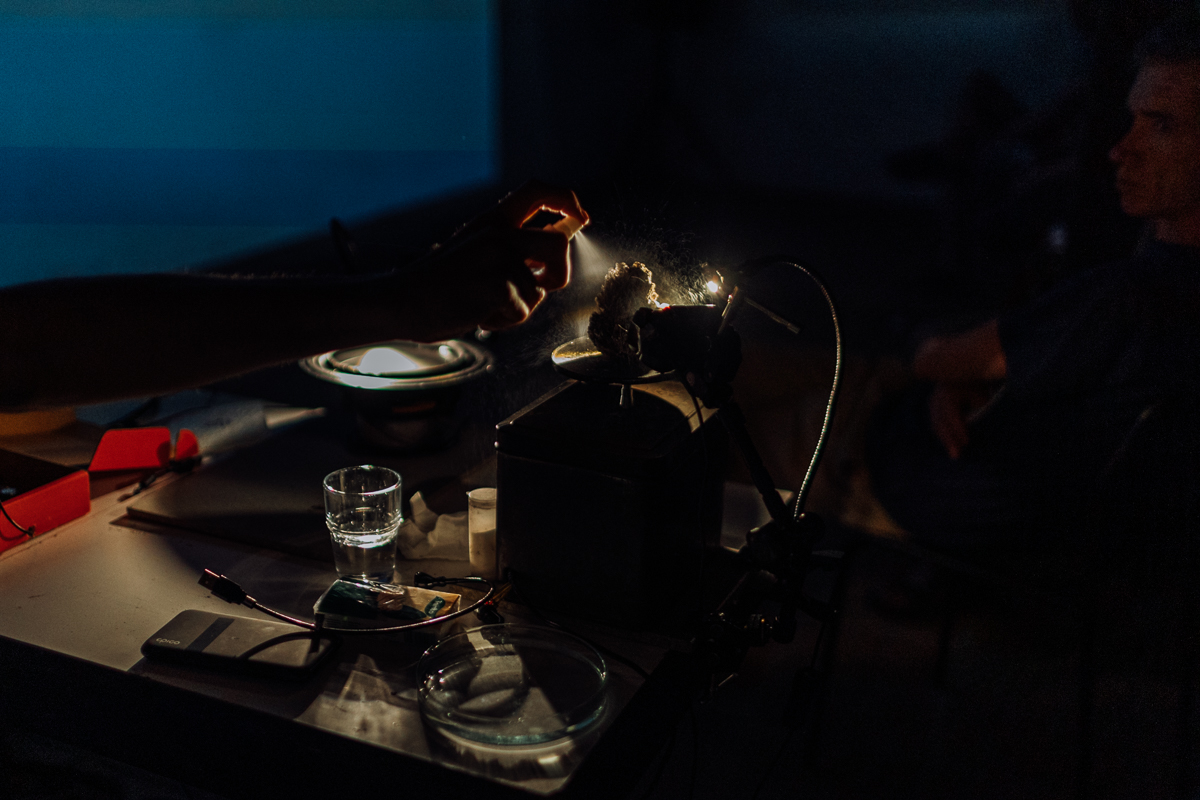Michal Kindernay – Phonotropic Blindness


“Scientists from countries along the [Black Sea] coast are drawing attention to the high number of dead whales […]. Experts believe that their deaths may be caused by underwater noise from military sonars from approximately 20 Russian navy vessels and ongoing military activities. Disoriented mammals are fleeing south. On Turkish or Bulgarian shores, they then get stranded on land in excessive numbers or get caught in fishing nets.”
– Zuzana Vitková: Dolphins in the Black Sea are mysteriously dying. Military sonars could be the cause, says marine biologist. In: Denník N. 13 May 2022.
Phonotropic Blindness is an audiovisual composition that brings the water element to life in its various forms: from playful bubbling of mineral springs, to the flow of water tamed in the pipes of our households, and to the dark rumbling of the depths of seas and oceans, incorporating sounds of naval traffic, communication, and industry. The multichannel sound composition reveals the delicate relationships between micro- and macro-events in the underground water and industrial environment. The live performance evokes not only alchemical experiments and pagan rituals but also microscopic observations of natural processes and laboratory analyses of chemical substances. Detailed shots of natural elements and abstract patterns emerging from sound frequency changes create a hypnotic experience. However, the surrounding sounds and their visualization also draw attention to the indifference towards the escalating sound pollution in aquatic areas and the omnipresence of this fundamentally life-giving element.
Heavy Heaven. 2019. Video, 4K. 3 min. Sound: Lloyd Dunn, Michal Kindernay.
Average emissions from air travel are growing at a rate of almost 6% per year, which is equivalent to the emissions produced by approximately 50 large coal power plants (according to the report by the International Council on Clean Transportation (ICCT)). If this trend continues, air travel emissions will become one of the main sources of greenhouse gases in the long term. The exhaust gases of engines contain several hundred substances that have a harmful effect on the environment. In 2016, global airlines transported 3.8 billion passengers, consuming approximately 35.8 million flights. This means that these aircraft produced approximately 781 million tons of carbon dioxide, which accounts for about two percent of total human emissions per year. In 2017, the number of passengers reached 4.1 billion (an increase of over 7 percent). Analysts also predict that airlines will transport approximately 6.9 billion passengers annually by 2035. Due to low or non-existent aviation fuel taxes, air travel has a competitive advantage over other modes of transportation in terms of lower travel costs. The video Heavy Heaven addresses the report on the end of the world. It is a daily view of the sky, which is marked by the scars of air travel. While we strive globally to reduce carbon footprints in industry and at the societal level, airports continue to expand without critical examination, new runways and terminals are being built, or even entire airports. But what is the real cost of fast and convenient travel in the sky?”
Insection. 2018. Video, Full HD. 3 min.
Slow movements of various insect species in an abstract, brightly illuminated environment create suggestive references to uncontrollable chaos, apathy, and the decay of social structures. The minimalist visual image is accompanied by ambient music that works with realistic sound and stillness.
Cargo. 2017. Video, Full HD. 6 min
The oceans are filled with cargo stored in containers on cargo ships, several of which pollute the environment more than all the cars in the world combined. The different types of markings and colours on the containers refer to logistics companies and their geopolitical influence. The standardised container architecture of goods transportation is one of the most visible symptoms of the global economy and neoliberalism. The containers are the same; they only differ in logo and colour, indicating their affiliation with several multinational cargo companies. The video was shot in the area of the cargo port in Hamburg, at the mouth of the Elbe River, the second-largest port in Europe and fifteenth-largest in the world. In 2014, nearly one hundred million cargo units were dispatched from there, equivalent to the contents of one standard six-meter container. The port area, including the built-up area, covers 73.99 km² and serves as transportation infrastructure connected to digital networks worldwide. Thousands of people-less agglomerations with hundreds of kilometers of streets spread across the planet.
Michal Kindernay is a Czech artist, author of video installations, video performances, and interactive applications utilizing sensor inputs. He has collaborated with visual artist and performer Milan Langer and the collective Victory Nox. His audiovisual installations bridge the fields and tools of art, technology, and science. He creates video performances and interactive installations, intermedia and documentary projects, as well as music and sound compositions. He is a co-founder of the art organisation yo-yo, the initiator of the RurArtMapa project, and a member of the collective gallery Školská 28 in Prague. He works as an educator at the Center for Audiovisual Studies at FAMU and at Prague College. His work often directly or indirectly touches upon ecological themes, and by applying technological approaches in relation to nature, he reflects on various layers of complex environmental issues.